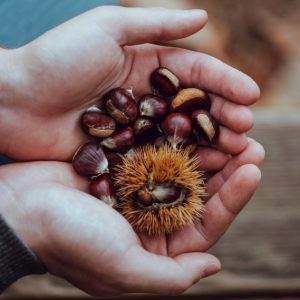Sweet Chestnut
Every October – December, Echo (our dog) and I pay the chestnut trees a visit looking for fallen nuts, but we have to be quick, or the squirrels will have had their fill and left nothing but empty shells. We have five Chestnut trees in our local park (Wythenshawe Park) at least five that I have found there maybe more, but we can regularly get as much as a carrier bag full of nuts. We bring them home and roast them in the oven with sea salt and fresh butter, but it’s just as easy to roast them on an open fire and eat them fresh out of the shell, they taste like a sweet potato and are delicious, crushed up and mixed in with sprouts and chopped up bacon lardons.
Where to find them
It’s a safe bet to say you will have Chestnut trees in your local area, especially in parks and woodland, but you can also buy Chestnut trees from your garden centre, as they seem to have gained popularity to plant in large gardens. They are fast growers and all chestnuts are large trees, most topping 20 metres, with some varieties reaching 40 metres.
You can eat and make purée, sweet candies or just no messing straight from the shell, here are some recipes for Chestnuts that can be found here .
Tip: Before going to collect Chestnuts be sure to take gloves or risk prickly fingers.
Harvest in October – December the nuts are ripe when they drop from the trees as the chestnut burrs (the outer spiny skin) burst, but some nuts will need removing from their skin. Wearing strong gloves, pull open the burrs and remove the nuts. Chestnuts are be kept in the fridge to prevent them from drying out.
Candied Chestnuts Recipe
- Digestive health – chestnuts reduce cholesterol levels and stabilize blood sugar levels. They also reduce the risk of constipation and intestinal complications such as diverticulosis.
- Increased brain function – chestnuts contain fat-soluble B vitamins that promote healthy skin, produce red blood cells and improve brain function.
- Increased energy levels – chestnuts contain high amounts of carbohydrates, which are needed for short and long term energy. They also help with nervous system function.
- Stronger bones – chestnuts contain copper, which is a trace mineral that enhances bone strength and boosts the immune system.
- Decreased risk of developing disease – chestnuts contain manganese, which is a trace mineral that fights off free radicals in the body and reduces the risk of heart disease and cancer. It also plays a key role in the ageing process and helps prevent blood-clotting.
- Do not contain gluten – chestnuts are of great benefit to patients with celiac disease, which is a disease that upsets the small intestine.
The sweet chestnut was held in high regard in ancient Greece and was a delicacy reserved for the elite. Honey was made of it, while numerous therapeutic properties were attributed to the chestnut. There are many recipes described in ancient literature and the sweet chestnuts are frequently mentioned in works by ancient Greek writers such as Homer, Xenophon and Hippocrates.
By the end of the Middle Ages the chestnut had a bad reputation and was associated with indigestion, headache, flatulence and an increased sex drive. Due to the huge increase in population the sweet chestnut became in certain parts of Europe the people’s food number one. Because the chestnut tree is an easy and rapid growing tree, he was planted everywhere where no other crops, such as cereals, wanted to grow. This harmed the quality of the nuts that became vulnerable for diseases. Fortunately, today’s chestnut again has a sound reputation. More articles here.











